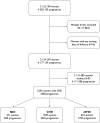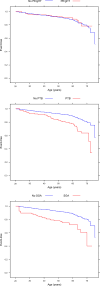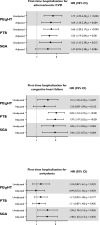Pregnancy complications and long-term risk of cardiovascular events in women with structural heart disease
- PMID: 39277187
- PMCID: PMC11404238
- DOI: 10.1136/openhrt-2024-002833
Pregnancy complications and long-term risk of cardiovascular events in women with structural heart disease
Abstract
Background: To determine the frequency of pregnancy complications and their association with the risk of cardiovascular outcomes in women with structural heart disease (SHD).
Methods: This nationwide registry-based cohort study included women in Sweden with SHD (pulmonary arterial hypertension, congenital heart disease or acquired valvular heart disease) with singleton births registered in the national Medical Birth Register (MBR) between 1973 and 2014. Exposures were pregnancy complications; pre-eclampsia/gestational hypertension (PE/gHT), preterm birth and small for gestational age (SGA) collected from MBR. The outcomes were cardiovascular mortality and hospitalisations defined from the Cause of Death Register and the National Patient Register. Cox regression models were performed with time-dependent covariates, to determine the possible association of pregnancy complications for cardiovascular outcomes.
Results: Among the total of 2 134 239 women included in the MBR, 2554 women with 5568 singleton births were affected by SHD. Women without SHD (N=2 131 685) were used as a reference group. PE/gHT affected 5.8% of pregnancies, preterm birth 9.7% and SGA 2.8%. Preterm birth (adjusted HR, aHR 1.91 (95% CI 1.38 to 2.64)) was associated with an increased risk of maternal all-cause mortality. PE/gHT (aHR 1.64 (95% CI 1.18 to 2.29)) and preterm birth (aHR 1.56 (95% CI 1.19 to 2.04)) were associated with an increased risk of hospitalisations for atherosclerotic CVD.
Conclusions: Pregnancy complications were frequent in women with SHD. With a median follow-up time of 22 years, preterm birth was associated with a higher risk of cardiovascular mortality, and PE/gHT and preterm birth were associated with cardiovascular morbidity. In women with SHD, pregnancy complications may provide additional information for the risk assessment of future cardiovascular outcomes.
Keywords: HEART FAILURE; Heart Valve Diseases; Pregnancy; Pulmonary Arterial Hypertension.
© Author(s) (or their employer(s)) 2024. Re-use permitted under CC BY-NC. No commercial re-use. See rights and permissions. Published by BMJ.
Conflict of interest statement
Competing interests: ETC, LL, ML and BL report no disclosures. CC reports speaker fees or advisory board participation fees from AstraZeneca, Bristol Myers Squibb, Bayer, Novartis, Orion Pharma and Pfizer.
Figures






References
Publication types
MeSH terms
LinkOut - more resources
Full Text Sources
